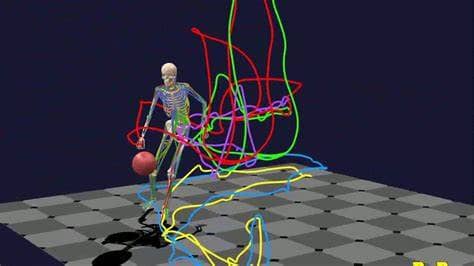Injury Prevention through Biomechanics
Without doubt, in the dynamic and physically demanding world of basketball. Certainly, injuries can not only sideline players. Rather yet, also significantly impact a team’s performance and an athlete’s career.
Important to realize, by harnessing the power of biomechanics. By and large, players and teams. Equally important, can adopt strategies. Evidently, that markedly reduce the risk of common injuries.
As a consequence, ensuring athletes stay in the game longer. In addition, perform at their peak.
With the result that, this exploration into injury prevention. As such, through biomechanics. Most definitely, sheds light on how an understanding of movement science.
Essentially, can be a game-changer in safeguarding players’ health and longevity in the sport.

The Role of Biomechanics in Injury Prevention
In the first place, biomechanics, is the study of the mechanics of the body’s movements. For this reason, offers invaluable insights into how athletes can optimize their movements to prevent injury.
For the same reason, by analyzing the forces exerted on the body during basketball’s myriad activities—jumping, landing, cutting, and pivoting.
All in all, biomechanics can identify movement patterns that may predispose athletes to injury.
Most compelling evidence, this understanding enables the development of targeted training programs.
For that reason, that not only enhance performance but also fortify the body against common basketball injuries.

Common Basketball Injuries and Biomechanical Insights
Notwithstanding, basketball, with its intensive physical demands, is associated with a variety of injuries. That is, from sprains and strains to more severe ligament tears and fractures.
Such that, among the most common are:
Ankle Sprains: In particular, often occurring during rapid changes in direction or landing awkwardly from a jump.
Nevertheless, biomechanical analysis can help in identifying improper landing techniques and ankle instability. As a result, leading to targeted exercises that strengthen the ankle and improve proprioception.
Anterior Cruciate Ligament (ACL) Injuries: In that case, typically resulting from non-contact mechanisms such as abrupt stops or cuts.
In the same way, understanding the biomechanics of knee movement and stability. Evidently, can inform training that emphasizes proper technique and knee strengthening. Thereupon, reducing the risk of ACL tears.
Patellar Tendinitis (Jumper’s Knee): On this occasion, it’s a result of repetitive jumping and landing. Particularly, leading to overuse of the knee’s patellar tendon.
Similarly, biomechanical evaluations can guide the adjustment of jumping and landing mechanics to distribute forces more evenly across the knee.

Mitigating Injury Risks through Biomechanical Approaches
Generally, preventing injuries in basketball involves more than just recognizing the risks. Additionally, it requires a proactive approach to training and preparation that incorporates biomechanical principles:
Strength and Conditioning: That is to say, tailored strength and conditioning programs. Specifically, that focus on the muscles most involved in basketball-specific movements.
Comparatively, can enhance stability and reduce the likelihood of injury.
Proper Technique Training: At any rate, coaching that emphasizes biomechanically sound techniques for jumping, landing, and cutting.
Apparently, can dramatically decrease injury risks by ensuring that movements are as efficient and safe as possible.
Wearable Technology: Additionally, advances in wearable technology allow for real-time biomechanical analysis.
In essence, providing immediate feedback to athletes and coaches on movement patterns that could lead to injury, facilitating swift corrections.

Conclusion
In summary, understanding and applying biomechanical principles in basketball offers a powerful strategy for injury prevention.
Since, by focusing on the mechanics of movement, players can not only optimize their performance but also significantly reduce their risk of common injuries.
Otherwise, this proactive approach to injury prevention, grounded in biomechanics, ensures that players can enjoy longer, healthier careers. Thus, contributing to the sustainability of their teams and the sport.
Furthermore, through education, targeted training, and technology, the basketball community can embrace biomechanics as a key element in injury prevention.
Moreover, safeguarding the health and well-being of athletes at all levels of the sport.
Do you feel the urge to be generous sometimes?
Not all donations are created equally. Most don’t serve the intended purpose. Our brand-new formula assures you that donated funds are used appropriately. Plus, the donations are going for a great cause.
Your donation is utilized for sustainable, all-natural, organic purposes, such as health initiatives.
Try making a donation today and notice how it brightens up your day. Don’t let anything hold you back.
Donations are accepted at https://pay.myhoopshub.com/Donation

Biomechanics


A Basketball Handbook
Master the fundamentals of basketball with ease!
“A Basketball Handbook” is your go-to resource for mastering the essentials of the game. From dribbling and shooting to advanced tactics and techniques, this comprehensive guide covers it all.
Perfect for players, coaches, and fans alike, this handbook is designed to elevate your basketball skills and knowledge. Learn from the best and apply practical tips to improve your game, whether on the court or from the sidelines.
Transform your basketball experience! Grab a copy of “A Basketball Handbook” now at: https://www.authorhouse.com/en/bookstore/bookdetails/256122-A-Basketball-Handbook#bookCoverZoomModal

